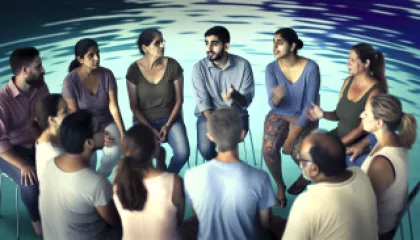Embracing Sensory Processing: An Insightful Perspective
Embracing Sensory Processing: An Insightful Perspective
The Nuanced World of Sensory Processing
As a society, we often take our senses for granted, overlooking the profound impact they have on our daily lives. However, for individuals grappling with sensory processing differences, the world can be a vastly different and often challenging experience. Sensory processing is the neurological process that organizes the sensations we receive from our environment and our own bodies, enabling us to use those sensations effectively. When this system is not functioning optimally, it can lead to a range of issues that profoundly affect an individual's physical, emotional, and social well-being.
In this opinion piece, we will explore the nuanced world of sensory processing, delving into the complexities and the remarkable resilience of those who navigate it. Through the lens of personal insights and scientific research, we will uncover the unique perspectives of Hal Harrison, a writer and advocate who has dedicated his life to raising awareness about sensory processing differences.
Hal Harrison's Journey: Navigating the Sensory Landscape
Hal Harrison's life has been a testament to the power of understanding and embracing one's own sensory needs. From an early age, he recognized that his experiences of the world were vastly different from those of his peers. "Growing up, I always felt like I was on the outside, looking in," Hal recalls. "The sounds, the textures, the lights – they all seemed to overwhelm me in ways that my friends couldn't quite understand."
As Hal navigated the challenges of childhood and adolescence, he found himself struggling to fit in, often misunderstood and labeled as "sensitive" or "difficult." It wasn't until his early twenties that he stumbled upon the concept of sensory processing disorder (SPD), a condition characterized by the brain's inability to accurately interpret and respond to sensory information.
"The moment I learned about SPD, it was like a lightbulb went off in my head. Suddenly, everything made sense – the reason why certain fabrics felt like they were burning my skin, why loud noises would send me into a panic, why I always preferred quiet, dimly lit spaces. It was a revelation."Hal Harrison
Armed with this newfound understanding, Hal embarked on a journey of self-discovery, determined to not only find ways to manage his sensory challenges but to also share his story and help others who were grappling with similar experiences.
The Complexity of Sensory Processing
Sensory processing is a complex and multifaceted phenomenon that encompasses the way our brains interpret and respond to the various sensations we encounter throughout the day. These sensations can include touch, sound, sight, smell, taste, and even the internal sensations of our own bodies, such as hunger, fatigue, and pain.
For individuals with typical sensory processing, these signals are seamlessly integrated and organized, allowing them to navigate their environment with relative ease. However, for those with sensory processing differences, this integration can be disrupted, leading to a range of challenges and experiences that can significantly impact their daily lives.
Sensory Sensitivity and Sensory Seeking
One of the primary ways in which sensory processing differences manifest is through either sensory sensitivity or sensory seeking behaviors. Sensory sensitive individuals may find certain sensations overwhelming or even painful, leading them to avoid or withdraw from specific stimuli. On the other hand, sensory seeking individuals may crave intense sensations, engaging in behaviors that provide them with the stimulation they need.
Hal's experience aligns with the sensory sensitive end of the spectrum. "I've always been acutely aware of my senses, and certain things just seem to trigger me in a way that's hard to explain," he shares. "The sound of a blender or the feel of certain fabrics – they can send me into sensory overload, leaving me feeling anxious and disoriented."
For Hal, navigating these sensory challenges has been a lifelong journey, one that has required him to develop a deep understanding of his own needs and limitations. "It's not just about avoiding the things that bother me," he explains. "It's about finding ways to create a sensory environment that allows me to function at my best, whether that's through the use of noise-cancelling headphones or carefully curated clothing choices."
The Neurological Basis of Sensory Processing
Sensory processing differences are rooted in the way our brains process and interpret the information we receive from our senses. Researchers have identified several key factors that contribute to these differences, including:
- Neurological Wiring: The way in which the sensory pathways in the brain are connected and organized can impact how effectively sensations are integrated and interpreted.
- Neurotransmitter Imbalances: Imbalances in the levels of certain neurotransmitters, such as serotonin and dopamine, can affect how the brain responds to sensory input.
- Neuroplasticity: The brain's ability to adapt and change in response to experience can influence how individuals process and respond to sensations over time.
These neurological factors can manifest in a wide range of sensory processing profiles, from heightened sensitivity to certain stimuli to a desire for intense sensory experiences. Understanding the underlying neurological basis of these differences is crucial in developing effective strategies for managing and supporting individuals with sensory processing challenges.
The Impact of Sensory Processing on Mental Health
One of the most significant impacts of sensory processing differences is the effect they can have on an individual's mental health. Anxiety, depression, and even post-traumatic stress disorder (PTSD) have all been linked to sensory processing challenges, as the constant struggle to manage overwhelming sensations can lead to profound emotional and psychological strain.
Hal's personal experiences have given him a deep understanding of this connection. "The sensory overload I experience can be absolutely debilitating," he shares. "It's like my brain is in a constant state of fight-or-flight, always on the alert for potential threats. That level of stress and anxiety takes a huge toll, both physically and mentally."
For Hal, finding ways to manage his sensory needs has been crucial in maintaining his mental well-being. "It's not just about coping with the sensory challenges themselves," he explains. "It's about creating a lifestyle and environment that supports my overall mental health and allows me to thrive, despite the obstacles I face."
The Importance of Sensory-Focused Interventions
In recent years, there has been a growing recognition of the importance of sensory-focused interventions in supporting individuals with mental health challenges. These interventions, which can include techniques like sensory processing exercises and sensory processing activities, aim to help individuals better regulate their sensory experiences and manage the emotional and psychological impacts of sensory processing differences.
For Hal, incorporating these types of interventions into his self-care routine has been transformative. "I've found that things like deep pressure touch, calming scents, and even just taking the time to tune into my own body's sensations can make a huge difference in my overall well-being," he shares. "It's not a magic bullet, but it's a crucial part of the toolkit I use to maintain my mental health and navigate the challenges of daily life."
The Resilience of the Sensory-Diverse Community
Despite the significant challenges faced by individuals with sensory processing differences, the sensory-diverse community has demonstrated remarkable resilience and determination. Through advocacy, education, and the development of supportive communities, these individuals are not only raising awareness but also creating meaningful change.
Hal's own journey has been a testament to this resilience. "When I first discovered that I was dealing with sensory processing challenges, I felt so alone and misunderstood," he reflects. "But as I've connected with others who share similar experiences, I've been amazed by the strength and creativity of this community. We're not just surviving – we're thriving, and we're committed to making the world a more inclusive place for everyone."
The Power of Self-Advocacy
A key aspect of this resilience is the power of self-advocacy. By learning to understand and communicate their sensory needs, individuals with sensory processing differences are empowered to advocate for themselves and create the support systems they need to succeed.
"It's not always easy, and there are still a lot of misconceptions and barriers to overcome," Hal acknowledges. "But when you know yourself, when you can articulate your needs and challenges, it becomes so much easier to navigate the world and find the accommodations and resources you need to thrive."
Building a Sensory-Inclusive Society
Beyond individual self-advocacy, the sensory-diverse community is also working to create a more sensory-inclusive society. Through advocacy efforts, educational initiatives, and the development of sensory-friendly spaces and experiences, these individuals are challenging the status quo and driving real change.
"It's not just about accommodating the needs of people with sensory processing differences," Hal emphasizes. "It's about creating a world that celebrates the diversity of human experience and recognizes the value that each individual brings to the table. When we embrace the unique perspectives and needs of the sensory-diverse community, we all benefit."
Embracing the Richness of Sensory Diversity
As we delve deeper into the world of sensory processing, it becomes clear that the experiences and challenges faced by those with sensory processing differences are not just individual struggles, but rather a reflection of the profound diversity that exists within the human experience.
Hal's story is a poignant reminder that sensory processing differences are not disabilities, but rather variations in the way we perceive and interact with the world around us. By embracing this diversity and creating environments and systems that support the unique needs of all individuals, we have the power to unlock a more inclusive, compassionate, and enriching world for everyone.
Through Hal's journey and the stories of others like him, we are invited to expand our understanding of what it means to be "normal" and to challenge the notion that there is a single, homogenous way of experiencing the world. In doing so, we open the door to a deeper appreciation for the remarkable complexity and beauty of the human experience, and the immense value that sensory diversity brings to our shared existence.
Conclusion: Towards a Sensory-Inclusive Future
As we reflect on the insights and perspectives shared in this exploration of sensory processing, it becomes clear that embracing and celebrating the diversity of human experience is not just a noble goal, but a necessity for the well-being and flourishing of all individuals.
Through the lens of Hal Harrison's personal journey, we have come to understand the profound impact that sensory processing differences can have on an individual's mental health, social well-being, and overall quality of life. But more importantly, we have witnessed the remarkable resilience and determination of those who navigate these challenges, and the transformative power of self-advocacy and sensory-focused interventions.
Looking towards the future, the sensory-diverse community and their allies are charting a course towards a more inclusive and supportive world – one that recognizes the value of diverse sensory experiences and creates the necessary accommodations and resources to empower individuals of all sensory profiles to thrive.
By embracing the richness of sensory diversity, we have the opportunity to cultivate a society that is more compassionate, more understanding, and more attuned to the nuanced and multifaceted nature of the human experience. It is a future that holds the promise of greater understanding, deeper connections, and the unleashing of the full potential of every individual, regardless of their sensory profile.
As we move forward, let us be inspired by the stories and insights shared here, and let us commit ourselves to the ongoing work of creating a world that celebrates the diversity of sensory experience, and empowers all individuals to live, learn, and thrive in a way that honors their unique needs and perspectives.
In the end, the journey of embracing sensory processing is not just about individual growth and resilience – it is about the transformative power of recognizing and honoring the full spectrum of human diversity. By walking this path together, we can build a future where sensory differences are celebrated, not stigmatized, and where every individual is empowered to embrace the richness of their own sensory experience.






